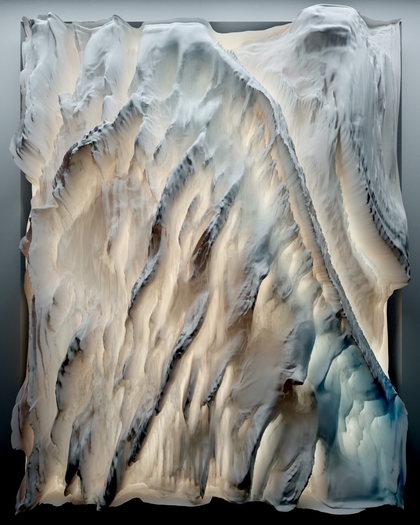Machine Hallucinations - Latent Study: Mars is an exploration of the relationship between memory and dreams, recognition and perception, offering a new kind of cognitive cartography for data universes by using a neural network trained on 1.5 million archival photographic memories of HiRISE telescope of MRO Mars. A poetic journey in the mind of a machine explored with vast synthetic landscapes of Mars to image a space yet reachable by humankind. Providing texture to this still unfamiliar place, Machine Hallucinations – Latent Study : Mars illustrates a dreamscape of possible futures and hidden pasts.
HiRiSE (High Resolution Imaging Science Experiment) is the most powerful camera ever sent to another planet, one of six instruments onboard the Mars Reconnaissance Orbiter. We launched in 2005, arrived at Mars in 2006 and have been imaging ever since. Our camera’s high resolution capability (imaging up to 30 centimeters per pixel) remains unprecedented for any existing orbiter in the study of the Red Planet, as well as being an indispensable instrument for helping to select landing sites for robotic and future human exploration. In the past decade, we’ve also imaged avalanches in progress, and discovered dark flows that may or may not be briny seeps. Hundreds of science papers have been published with our data.
These machine-hallucinated images come to represent collective memory, hidden layers of history, and then consciousness of a planet that, otherwise, might remain unseen. In this project NVIDIA’s StyleGAN algorithm (Style-Based Generator Architecture for Generative Adversarial Networks by Tero Karras, Samuli Laine, Timo Aila) was modified, and custom latent space explorer software was developed by Refik Anadol Studio.A parametric data sculpture created with 12 terabytes of datasets, images downloaded from the HiRISE telescope, which recorded the entire surface of Mars. HiRISE (High Resolution Imaging Science Experiment) is the most powerful camera ever sent from Earth to travel the solar system. Launched in 2005 by a team of planetary scientists, geologists, and researchers form the University of Arizona, SETI Institute, an other research institutions, HiRISE reached Mars in 2006.
“This is a study of celestial structure that you don't see every day. We know it's there, but we don’t see it; we have a feeling that it’s real. [The artwork is] a kind of AI research, where we’re trying to create a synthetic reality of the surfaces of Mars. [From the HiRISE dataset], we’ve got huge AI studies, which create synthesized data sculptures."





